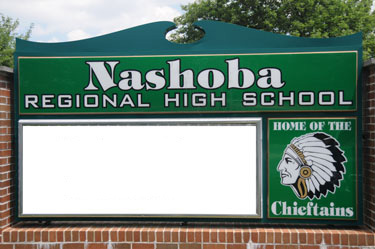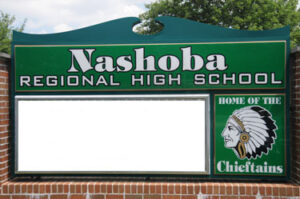
With the school year still new, the Nashoba School Committee got a first look at last spring’s MCAS scores for the district at their meeting Tuesday night, and heard reflections from Nashoba Regional High School’s principal, after his first year of service, on what is needed at the school. Much of the rest of the Committee meeting was devoted to reviewing and approving new and existing policies, including a new teacher evaluation system.
Looking at the spring MCAS results, the district continued to fare well. Compared with other grades across the state, each Nashoba school placed at least in the top third of each grades’ Math, Science, and English Language Arts tests, according to calculations released by The Boston Globe. Students take the exam in grades 3 through 8, as well as in grade 10. The tests’ rankings are listed (highest to lowest) as Advanced, Proficient, Needs Improvement and Warning/Failing.
Stow’s schools can claim their own bright spots. At Hale Middle School, in Math, grade 6 ranked fourth out of 554 schools’ sixth graders. Also in Math, Hale seventh graders came in 10th out of 467, and eighth graders ranked 17th of 465 schools.
At Nashoba Regional High School, 95% of last year’s sophomores were deemed advanced or proficient in ELA, 92% earned one of those rankings in Math (75% earned advanced), and 87% in Science. In order to graduate from high school, grade 10 students must earn at least a proficient on each of the three MCAS subjects.
Offering averages for each grade and test over the past four years, Superintendent Michael Wood said, “We continue to be very steady, very solid.” However, he emphasized, “What is of concern to me is the growth.”
Here, Wood pointed to the Progress and Performance Index, a relatively new state index designed to basically measure progress toward each school’s testing and educational goals. While Nashoba students as a whole met the proficiency target of 75 points over four years (earning 76 points), Wood noted the sub-groups of students with high needs, low income, and disabilities did not meet PPI, each group earning at least 10 points less than the target. “When we look at our comparison band growth in other districts, they’re better than that,” he commented.
But, because the PPI report breaks down areas where a district lost points, Wood assured, “Now we have the ability to see if, say, you’re a high achieving student, are you flat-lined, or can you develop? What can we do to continue your growth?
“I’ve asked our principals to dig down deeper into the data, to ask what can we do better,” he continued. “Because we really don’t want to let another year go by.”
Dr. Graham’s Diagnosis
In a presentation reviewing his first year as NRHS principal, Dr. Parry Graham offered his view on what the high school does well, could do better, and should do in the future.
Looking at what he found the school does well, Graham praised the people throughout the school, from maintenance to students to teachers. He also lauded a school culture that successfully encourages students to support each other, rather than break into cliques or to feel isolated.
One area Graham identified as a target for improvement was collaboration between teachers, with Graham saying he is working on techniques such as making room in some teachers’ schedules to work with each other. Also noting that NRHS could be more innovative, Graham remarked, “I always said we’re a very strong, traditional high school. Now I’d like us to be known as a very strong, innovative high school. I want to be building out the next EMT program.” (The Nashoba EMT program is one of only a few among U.S. high schools.)
The third area of need is personalizing education, to engage lower-achieving and higher-need students, he said. A few potential ways Graham listed for addressing this included changing the freshman experience and offering more flexibility in how course credits are earned.
Elsewhere in high school news, the Committee reviewed new safety rules around use of the Science equipment. This came into focus last year after the administration began considering updating the school labs. The result was a 23-page draft of a “Chemical Hygiene and Science Laboratory Safety Plan,” addressing nearly every aspect of staying safe around materials and procedures used in students’ Science experiments. All Science students and their parents, along with teachers, will be required to sign the final version.
As for District as a whole, another landmark policy in the works has been the new educator evaluation protocol. Though built around state mandates, Michael Wood stressed the new protocol combines several very similar elements from Nashoba’s current teacher evaluation. The new evaluation will be a year-long process of teachers setting goals and assessing themselves, then being evaluated by a Nashoba administrator.
Teachers must be evaluated in the areas of curriculum, planning, and assessment; teaching all students; family and community engagement; professional culture; and attainment of professional practice and student learning goals. At the end of the evaluation cycle, a teacher will be given one of five ratings, ranging from “unsatisfactory” to “exemplary”.
The Committee unanimously voted in both the Laboratory Safety Plan and teacher evaluation protocol. (Stow Reps. Lynn Colletti and Jeff Odell were absent.)
In other policies, the Committee unanimously approved to not make any substantial changes to the existing policies up for review this year. These policies were; Use of School Facilities, School District Legal Status; School Committee Operational Goals; Evaluation of School Committee Operational Procedures; School Committee Legal Status; and School Committee Powers and Duties.
For a look at full copies of these and other School Committee policies, go to www.nrsd.net, click on “School Committee,” then “Policy Subcommittee,” then “District Policies.”
In other votes, the Committee unanimously approved Wood’s appointment to the Assabet Valley Collaborative as member (he also serves as board chairman), and to the MA Association of Regional Schools as a board member. The Collaborative is an educational network for special education students, while MARS advocates for regional school issues in Massachusetts.
